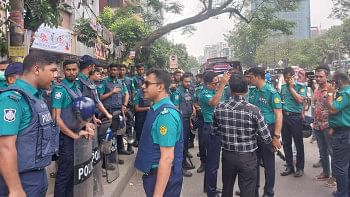Valour of Rajarbagh goes on display
The Bangladesh Police Liberation War Museum was inaugurated in the capital's Rajarbagh Police Lines yesterday to portray the valour the law enforcers there showed on the black night of March 25, 1971.
“It is our national duty to construct a separate building to house the museum and we will do it,” said Home Minister Muhiuddin Khan Alamgir at the inaugural ceremony.
The museum, housed in a tiny room of Rajarbagh Telecom Building, preserves some utensils used by the martyred members of the police lines and some rare photographs on the Liberation War.
Police personnel at Rajarbagh acquired the honour to be the first to build up resistance against the genocide of Bangalees by the Pakistani occupation forces beginning that night.
The nation and other police headquarters came to know that the country was under attack when wireless operator Mohammad Shahjahan Mia of Rajarbagh Police Lines announced, “We are already under attack…” around 11:30pm that night.
Speakers at yesterday's inauguration said, on information, police personnel from the police lines and the locals had put up barricades at three points centring the police lines that evening.
Tanks of the Pakistani army started rolling down the roads of the city streets but had to stop at these barricades at Shantinagar. This is when the policemen attacked them, armed with only .303 rifles, they said.
In the uneven fight that ensued, nearly all of the 1,000 police members of the police lines embraced martyrdom, they said.
Yesterday, the premier show of a documentary, “First Resistance in Liberation War”, based on the aforementioned resistance was also screened at the Rajarbagh Telecom auditorium.
The documentary reproduced almost all the happenings of the fateful night at Rajarbagh Police Lines and depicted the sacrifices made by the poorly equipped force.
Produced by Bangladesh Police, the documentary tried to find the answers as to why a disciplined force broke their chain of command and why the policemen, nearly unequipped, embraced certain death.
Home Minister Muhiuddin Khan Alamgir instructed the higher authority of Bangladesh Police to make it mandatory for all police personnel to watch the documentary so that they can take pride in what the force did during the Liberation War.
He said the documentary should be screened at cinemas across the country to make the new generation aware of the sacrifices made by the police force for the independence of the country.
Among others, Land Minister Rezaul Karim Hira, State Minister for Home Shamsul Haque Tuku, the inspector general of police, commissioner of Dhaka Metropolitan Police and family members of some of the martyred policemen attended the function.

 For all latest news, follow The Daily Star's Google News channel.
For all latest news, follow The Daily Star's Google News channel. 



Comments